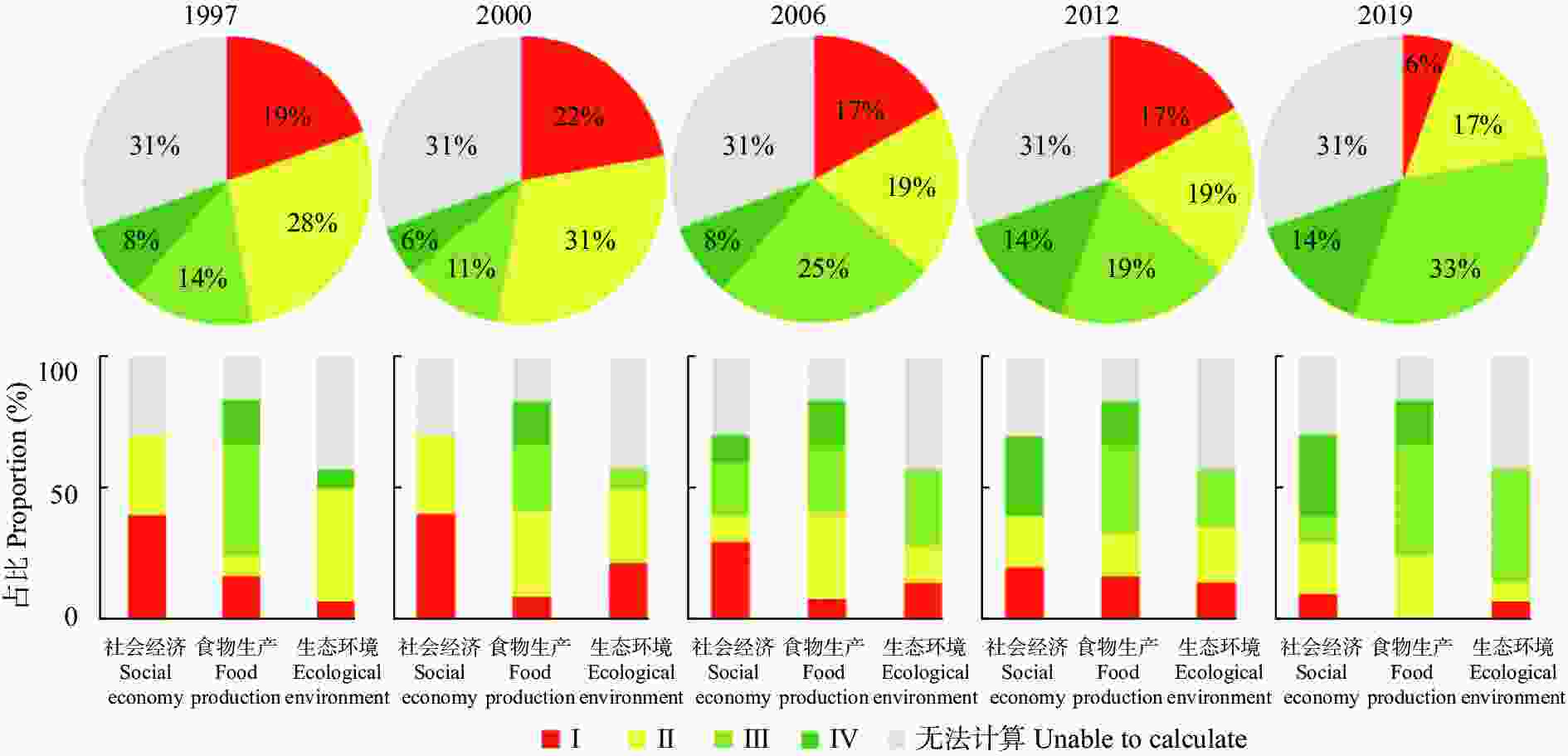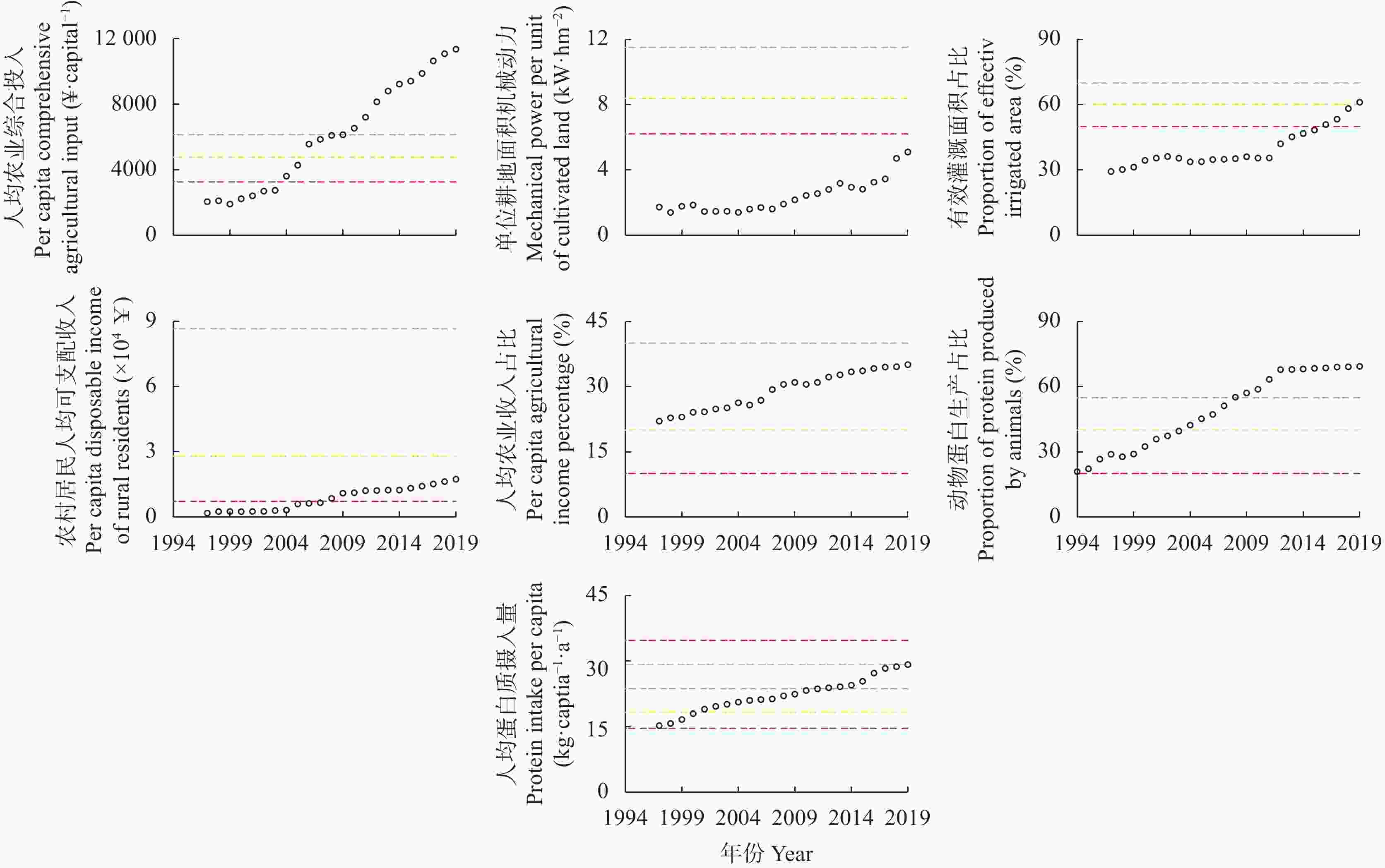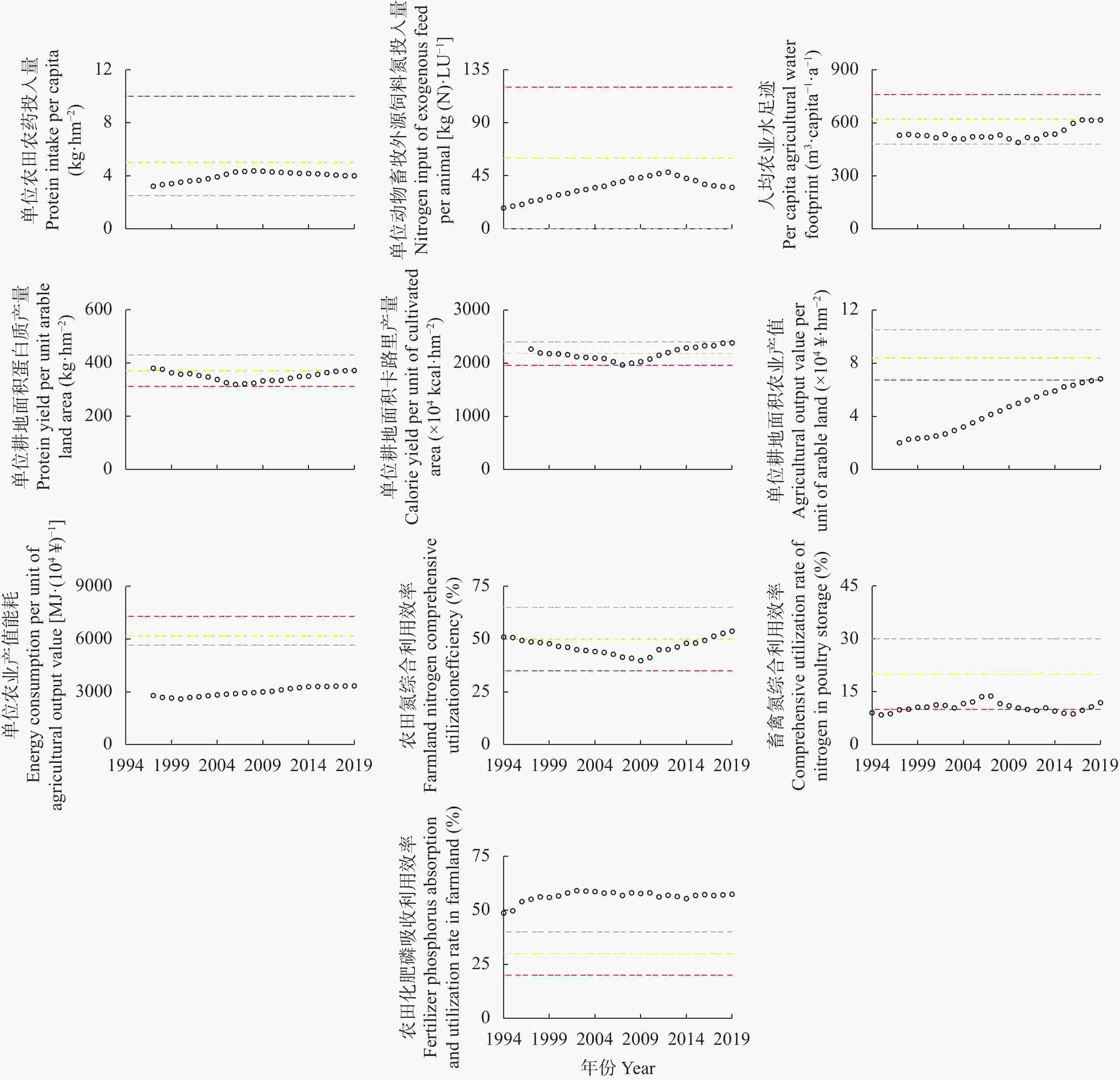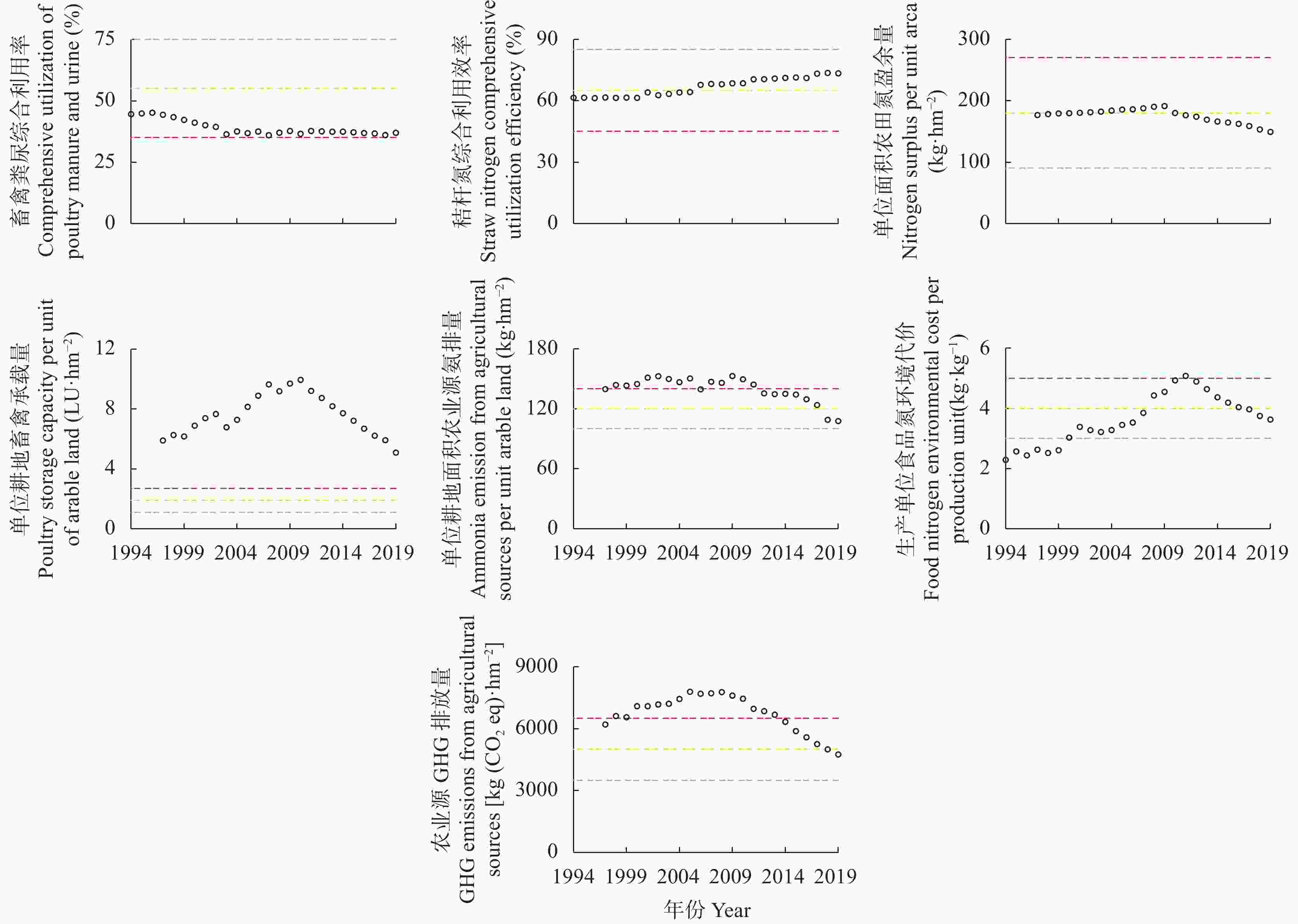Time variation characteristics of agricultural green development indexes in Lishu County,Jilin Province
-
摘要: 吉林省梨树县作为全国农业生产先进县, 始终走在农业绿色发展的前沿, 本研究将其作为典型案例, 通过已构建的中国农业绿色发展指标体系, 结合NUFER模型, 从社会经济、食物生产、生态环境3个方面, 分析1994—2019年梨树县农业绿色发展指标特征及其变化规律, 进一步探究吉林省县域农业绿色发展的推动及制约因素。结果表明, 1994—2019年梨树县农业绿色发展整体水平稳步提升, Ⅰ、Ⅱ级指标占比由47%下降到23%, Ⅲ、Ⅳ级指标占比由22%上升到47%。在社会经济方面, 人均农业综合投入和农村居民人均可支配收入逐年增加, 2019年较1994年分别增长454.6%和866.7%; 人均蛋白摄入量和动物生产蛋白占比有良好的改善, 均达到Ⅳ级水平; 农业机械化动力虽呈增长趋势, 但仍处在Ⅰ级水平, 有待提高。在食物生产方面, 单位农业产值能耗和农田化肥磷吸收利用效率多年来一直处于Ⅳ级水平, 但畜禽氮综合利用效率始终处在低级水平; 此外, 农药、化肥氮投入均在2019年达到Ⅲ级水平, 但过程中不是持续增长, 受年限的影响较大。在生态环境方面, 截止到2019年, 单位耕地面积因氮投入产生的氮排放、氮盈余及环境代价均呈好转趋势, 但畜禽粪尿综合利用率和单位耕地畜禽承载量始终处在Ⅰ级水平, 说明梨树县畜牧业发展仍有很大的挑战。综上, 资源未充分利用、环境污染和生态破坏严重制约吉林省县域农业绿色发展, 究其原因是种植结构单一、优质农产品产量低, 农药、化肥等投入量较高, 畜牧业养殖数量不稳定, 下一步急需合理开发利用黑土地资源, 大力推广测土配方施肥、保护性耕作等优秀农业技术, 解决优质农产品供需矛盾等问题, 减少对生态环境的伤害, 全面推进吉林省县域的农业绿色发展。Abstract: As an advanced agricultural production county in China, Lishu County in Jilin Province has always been at the forefront of green agricultural development; this study took it as a typical case. Through the established indicators system of Chinese agricultural green development, combined with the nutrient flows in food chain, environment and resources use (NUFER) model, it analyzed the characteristics and change rules of agricultural green development indicators in terms of social economy, food production, and ecological environment, from 1994 to 2019, in Lishu County. The driving and restricting factors of county agricultural green development in Jilin Province were further explored. The results showed that the overall level of agricultural green development in Lishu County has improved steadily from 1994 to 2019, with the number proportion of indicators of grade I and grade II decreasing from 47% to 23%, and the number proportion of indicators of grade III and grade IV increasing from 22% to 47%. In terms of social economy, the per capita comprehensive agricultural input and the per capita disposable income of rural residents have increased annually, and the per capita protein intake and the proportion of animal protein production have also improved, both reaching a grade IV level. Although the power of agricultural mechanization has shown an increasing trend, it is still at level I and needs to be improved. In terms of food production, the energy consumption per unit agricultural output value and the fertilizer phosphorus absorption utilization in farmland have been at level IV for many years; however, the comprehensive nitrogen use efficiency of livestock and poultry nitrogen has always been at a low level. The input of pesticides and fertilizer nitrogen reached level III in 2019; however, it did not increase continuously during the process, which was greatly affected by the years. In terms of the ecological environment, nitrogen emissions, nitrogen surplus, and environmental losses per unit cultivated land area due to nitrogen inputs all showed an improving trend from 1994 to 2019. However, the comprehensive utilization rate of livestock manure and the livestock and poultry carrying capacity per unit area was still at grade I, which meant that the development of the livestock industry still faces great challenges in Lishu County. Above all, the underutilization of resources, the environmental pollution, and ecological damage was caused by a single plantation structure, low yield of high-quality agricultural products, high input of pesticides and chemical fertilizers, and unstable numbers of livestock. It is therefore urgent to develop and utilize black land resources reasonably, to vigorously promote testing soil for formulated fertilization, improve conservational tillage and other excellent agricultural technologies, solve the contradiction between supply and demand of high-quality agricultural products, reduce damage to the ecological environment, and comprehensively promote the green development of agriculture in Jilin Province.
-
表 1 农业绿色发展指标体系及计算方法
Table 1. Indicators of green agricultural development and calculation methods
分类
Category指标
Indicator指标含义
Indicator implication计算公式
Calculation formula社会经济
Social economy人均农业综合投入
Per capita comprehensive agricultural input衡量政府财政对农业发展的支持程度, 正向指标
Measure the degree of government financial support for agricultural development, positive indicator农林水务投入量/农村人口数
Amount of investment in agriculture, forestry, and water affairs/rural population单位耕地面积机械动力
Mechanical power per unit cultivated land评价农业机械化程度, 正向指标
Evaluate the degree of agricultural mechanization, positive indicator农业机械总动力/耕地面积
Agricultural machinery total power/cultivated land area有效灌溉面积占比
Proportion of effective irrigation area衡量农业生产灌溉装备情况, 正向指标
Measure the situation of irrigation equipment, positive indicator.有效灌溉面积/耕地面积×100
Effective irrigation area/cultivated land area×100农村居民人均可支配收入
Per capita disposable income of rural residents评价区域农民收入水平现状, 正向指标
Evaluate the status quo of the regional farmers’
income, positive indicator数据来源于统计年鉴
Data comes from the statistical yearbook.人均农业收入占比
Per capita agricultural income percentage评价农业生产对农民收入的贡献, 正向指标
Evaluate the contribution of agricultural production to farmers’ income, positive indicator农村居民经营性收入/农民总收入
Rural residents’ operating income/total income of farmers动物蛋白生产占比
Proportion of animal protein production评价农业生产供给与居民膳食需求的匹配度, 正向指标
Evaluate the matching degree of agricultural production supply and residents’ dietary needs, positive indicator动物蛋白产量/ (动物蛋白产量+植物蛋白产量)
Animal protein yield/(animal protein yield+plant protein yield)人均蛋白摄入量
Protein intake per capita评价居民膳食营养状况, 正向指标
Evaluate the dietary nutrition status of residents, positive indicator∑(居民主要食品消费量×蛋白质含量)
∑(residents’ main food consumption×protein yield)农业人口高中学历及以上比例
Ratio of agricultural population with high school education or above衡量农村人口受教育程度, 正向指标
Measure the educational level of the rural population, positive indicator高中及以上人口数/人口总数×100
Population with high school and above/total population×100土地流转比例
Proportion of land transfer评价土地流转和集中程度, 正向指标
Evaluate the degree of land circulation and concentration, positive indicator土地流转面积/区域耕地面积×100
Land transfer area/cultivated land area×100城乡居民可支配收入比
Disposable income ratio of urban and rural residents评价城乡居民的收入差距, 负向指标
Evaluate the income gap between urban and rural residents, positive indicator城市居民可支配收入/农村居民可支配收入
Disposable income of urban residents/disposable income of rural residents食物生产
Food production单位农田农药投入量
Pesticide input per unit farmland评价农业生产中农药使用情况, 负向指标
Evaluate the use of pesticides in agricultural production, negative indicator农药使用量/总播种面积
Pesticide usage/total sown area单位动物畜牧外源饲料氮投入量
Nitrogen input of exogenous feed per animal反映种植业和畜牧业的匹配和耦合情况, 负向指标
Reflect the matching and coupling of planting and animal husbandry, negative indicator(畜牧业氮需求量−种植业氮供给量)/标准动物头数
(Nitrogen requirement in livestock−planting nitrogen supply)/number of standard animals人均农业水足迹
Per capita agricultural water footprint反映人均食物消费对水资源的消耗, 负向指标
Reflect the consumption of water resources by per capita food consumption, negative indicator.(主要食品消费量×单位食品水足迹) /人口数
(Main food consumption×food water footprint per unit food)/population单位耕地面积蛋白质产量
Protein production per unit cultivated land衡量种植业生产水平, 正向指标
Measure the production level of planting industry, positive indicator各种作物蛋白质总量/耕地面积
Total protein of various crops/cultivated land area单位耕地面积卡路里产量
Calorie yield per unit arable land评价农业生产水平, 正向指标
Evaluate the level of agricultural production, positive indicator(各种作物产品热量+动物产品热量)/耕地面积
(Calories of crop products +calories of animal products)/cultivated land area单位耕地面积农业产值
Agricultural output value per unit of cultivated land评价农业生产的经济增产价值, 正向指标
Evaluate the economic output value of agricultural production, positive indicator农业生产总值/耕地面积
Gross agricultural output value/cultivated land area单位农业产值能耗
Energy consumption per unit agricultural output value评价农业生产对能源的依赖程度, 负向指标
Evaluate the degree of dependence of agricultural production on energy, negative indicator∑(农业生产主要能源消费量×单位能源能值)/农业生产总产值
∑ (Agricultural production primary energy consumption×energy per unit energy source)/gross agricultural production value农田氮综合利用效率
Farmland nitrogen comprehensive utilization efficiency当年作物系统各种作物氮素携出量与氮素投入总量, 正向指标
Amount of nitrogen carried out by various crop and the total amount of nitrogen inputs in crop system in the current year, positive indicator(收获部位氮吸收量+秸秆部位氮吸收量)/农田氮总投入量×100
(Nitrogen uptake of harvest part+nitrogen uptake in straw)/total nitrogen input in farmland×100畜禽氮综合利用效率
Comprehensive nitrogen use efficiency of livestock衡量畜牧业生产效率, 正向指标
Measure the production efficiency of animal husbandry, positive indicator(畜禽主要产品氮吸收量+动物副产品氮吸收量)/畜禽氮总投入量×100
(Nitrogen absorption of main products of livestock and poultry+nitrogen absorption of animal by-products)/total input of nitrogen of livestock and poultry×100续表1 分类
Category指标
Indicator指标含义
Indicator implication计算公式
Calculation formula化肥磷吸收利用率
Fertilizer phosphorus absorption and utilization衡量农业生产磷肥利用效率, 正向指标
Measure the utilization efficiency of phosphate fertilizer in agricultural production, positive indicator(收获部位磷吸收量+秸秆磷吸收量)/农田磷总投入量×100
(Phosphorus uptake of harvest part+phosphorus uptake of straw)/total phosphorus input in farmland×100单位动物兽药投入
Veterinary drug input per unit animal评价畜牧业兽药使用水平, 为负向指标
Evaluate the level of veterinary drug use in animal husbandry, negative indicator数据来源于统计年鉴
Data comes from the statistical yearbook.农田灌溉水有效利用系数
Effective use coefficient of farmland irrigation water指征灌溉用水进入农田的比例, 正向指标
Indicate the proportion of irrigation water entering farmland, positive indicator数据来源于统计年鉴
Data comes from the statistical yearbook.生态
环境
Ecological environment畜禽粪尿综合利用率
Comprehensive utilization rate of livestock manure指征畜牧业生产中粪污资源化利用程度, 正向指标
Indicate the degree of manure resource utilization in animal husbandry production, positive indicator粪尿资源化利用量/畜禽粪尿产生量×100
Resource utilization of manure/manure production of livestock and poultry×100秸秆氮综合利用效率
Straw nitrogen comprehensive utilization efficiency指征种植业秸秆资源化利用程度, 正向指标
Indicate the degree of utilization of straw resources in planting industry, positive indicator(秸秆还田量+秸秆饲喂量+秸秆发电用量)/秸秆产生量×100
(Amount of straw returning to field+amount of straw feeding+amount of straw for electricity generation)/amount of straw produced×100单位农田氮盈余量
Nitrogen surplus per unit farmland反映农田氮投入适宜程度及对环境的压力, 负向指标
Reflect the suitability of nitrogen input in farmland and the pressure on the environment, negative indicator(农田总氮投入量−秸秆氮吸收量−收获部位氮吸收量)/耕地面积
(Total nitrogen input in farmland−nitrogen absorption of straw−nitrogen absorption of harvest part)/cultivated land area单位面积畜禽承载量
Livestock and poultry carrying capacity per unit area评价种植业消纳粪污能力与畜牧业粪污排放能力的匹配程度, 负向指标
Evaluate the matching degree between the manure consumption capacity of planting industry and the manure discharge capacity of animal husbandry, negative indicator区域畜禽养殖标准动物头数/耕地面积
Number of standard animal of regional livestock and poultry breeding/cultivated land area空气质量
Air quality衡量大气污染状况, 负向指标
Measure the state of air pollution, negative indicator环境空气质量标准
Ambient air quality standards单位面积农业源氨排放量
Ammonia emissions from agricultural sources per unit area评价农田氨排放能力, 负向指标
Evaluate the ammonia emission capacity of farmland, negative indicator(肥料+人畜动物氨挥发量) /耕地面积×100
(Fertilizer+ammonia volatilization amount of human and animal)/cultivated land area×100生产单位食品氮环境代价
Food nitrogen environmental cost per production unit每产生1 kg食物氮向环境中排放的氮量, 负向指标
Amount of nitrogen emitted to the environment for 1 kg food nitrogen production, negative indicator(种植业氮投入+畜牧业氮投入−食物氮含量)/食物氮含量
(Planting nitrogen input+animal husbandry nitrogen input−food nitrogen content)/food nitrogen content单位面积农业源温室气体(GHG)排放量
Greenhouse gas (GHG) emissions from agricultural sources per unit area整个食物系统的各种GHG排放量总和与耕地面积、园地、人工草地面积比值, 负向指标
Ratio of total amount of various GHG emissions in the whole food system to the area of cultivated land, garden land, and artificial grassland, negative indicator(畜牧业GHG排放量+种植业GHG排放量)/耕地面积
(GHG emissions from animal husbandry+GHG emissions from crop farming)/cultivated land area农膜资源化回收率
Agricultural film recycling rate指征农用薄膜回收和资源化利用程度, 正向指标
Indicating degree of recycling and resource utilization of agricultural film, positive indicator农膜回收利用量/农膜使用量×100
Amount of agricultural film recycling/amount of agricultural film used×100土壤侵蚀模数
Modulus of soil erosion指表层土壤在单位面积和单位时间内被剥蚀并发生位移的土壤侵蚀量, 负向指标
Refer to the amount of soil erosion that the topsoil is eroded and displaced per unit area and unit time, negative indicator水土流失面积/区域总面积×100
Soil erosion area/total area ×100地表水质量
Surface water quality评价地表水水质,为生态环境常规统计指标, 正向指标
Evaluate the water quality of surface water, a conventional statistical indicator of ecological environment, positive indicator数据来源于环境公报
Data from Environmental Bulletin地下水水质超标率
Ground water quality评价地下水质超标情况, 负向指标
Evaluate the situation of groundwater quality exceeding the standard, negative index(水质为IV、V和劣V类样点) /总测样点×100
(Sample points with IV, V and inferior V water quality)/total measurement sample points×100农药(抗生素)土壤残留超标率
Standard-exceeding rate of pesticides (antibiotics) residues in soil衡量农田土壤农药污染状况, 负向指标
Measure the pesticide pollution status of farmland soil, negative indicator标点数/总监测点数×100
Punctuation points/total monitoring points×100农田重金属污染超标比例
Proportion of exceeding the standard of farmland heavy metal pollution衡量农田土壤重金属污染状况, 负向指标
Measure the status of heavy metal pollution in farmland soil, negative indicator超标点数/总监测点数×100
Standard-exceeding points/total monitoring points×100表 2 农业绿色发展评价指标体系分级标准
Table 2. Grading criteria of agricultural green development evaluation index system
分类
Category指标
Indicator单位
Unit分级标准 Grading standard I II III IV 社会经济
Social
economy人均农业综合投入 Per capita comprehensive agricultural input ¥∙capita−1 ≤3259 3259~4786 4786~6140 ≥6140 单位耕地面积机械动力 Mechanical power per unit of cultivated land kW∙hm−2 ≤6.2 6.2~8.4 8.4~11.5 ≥11.5 有效灌溉面积占比 Proportion of effective irrigation area % ≤50 50~60 60~70 ≥70 农村居民人均可支配收入 Per capita disposable income of rural residents ×104¥ ≤0.7 0.7~2.8 2.8~8.8 ≥8.7 人均农业收入占比 Per capita agricultural income percentage % 0~10 10~20 20~40 ≥40 动物蛋白生产占比 Proportion of animal protein production % ≤20 20~40 40~55 ≥55 人均蛋白摄入量 Protein intake per capita kg∙capita−1∙a−1 <14.6, >34.7 14.6~18.3, 29.2~34.7 23.7~29.2 18.3~23.7 农业人口高中学历及以上比例 Ratio of agricultural population with high school education or above % 0~22.5 22.5~45 45~90 >90 土地流转比例 Proportion of land transfer % <20 20~40 40~60 >60 城乡居民可支配收入比 Disposable income ratio of urban and rural residents >2 1.6~2 1.2~1.6 <1.2 食物生产
Food production单位农田农药投入量 Pesticide input per unit of farmland kg∙hm−2 >10 5~10 2.5~5 <2.5 单位动物畜牧外源饲料氮投入量 Nitrogen input of exogenous feed per animal kg(N)∙LU−1 >120 60~120 0~60 ≤0 人均农业水足迹 Per capita agricultural water footprint m3∙capita−1∙a−1 >760 620~760 480~620 <480 单位耕地面积蛋白质产量 Protein production per unit cultivated land kg∙hm−2 <313 313~372 372~431 >431 单位耕地面积卡路里产量 Calorie yield per unit cultivated land ×104 kcal∙hm−2 <1960 1960~2180 2180~2400 >2400 单位耕地面积农业产值 Agricultural output value per unit cultivated land ×104 ¥∙hm−2 <6.7 6.7~8.4 8.4~10.5 >10.5 单位农业产值能耗 Energy consumption per unit agricultural output value MJ∙(104 ¥)−1 >7291 6197~7291 5650~6197 <5650 农田氮综合利用效率 Farmland nitrogen comprehensive utilization efficiency % 0~35 35~50 50~65 >65 畜禽氮综合利用效 率 Comprehensive nitrogen use efficiency of livestock % <10 10~20 20~30 >30 化肥磷吸收利用率 Fertilizer phosphorus absorption and utilization % 0~20 20~30 30~40 >40 单位动物兽药投入 Veterinary drug input per unit animal ¥∙LU−1 >244 122~244 61~122 <61 农田灌溉水有效利用系数 Effective use coefficient of farmland irrigation water % <0.50 0.5~0.55 0.55~0.60 >0.60 生态环境
Ecological environment畜禽粪尿综合利用率 Comprehensive utilization rate of livestock manure % <35 35~55 55~75 >75 秸秆氮综合利用效率 Straw nitrogen comprehensive utilization efficiency % <45 45~65 65~85 >85 单位农田氮盈余量 Nitrogen surplus per unit farmland kg∙hm−2 >270 180~270 90~180 <90 单位面积畜禽承载量 Livestock and poultry carrying capacity per unit area LU∙hm−2 >2.7 1.9~2.7 1.1~1.9 <1.1 空气质量 Air quality d >30 20~30 10~20 <10 单位面积农业源氨排放量 Ammonia emissions from agricultural sources per unit area kg∙hm−2 >140 120~140 100~120 <100 生产单位食品氮环境代价 Food nitrogen environmental cost per production unit kg∙kg−1 >5 4~5 3~4 <3 单位面积农业源温室气体排放量 Greenhouse gas emissions from agricultural sources per unit area kg(CO2 eq)∙hm−2 >6500 5000~6500 3500~5000 <3500 农膜资源化回收率 Agricultural film recycling rate % <40 40~60 60~80 >80 土壤侵蚀模数 Modulus of soil erosion % >30% 20~30% 10~20% <10% 地表水质量 Surface water quality % <50 50~70 70~90 >90 地下水水质超标率 Ground water quality % >50 30~50 10~30 <10 农药(抗生素)土壤残留超标率 Standard-exceeding rate of pesticides (antibiotics) residues in soil % >10 5~10 2~5 2 农田重金属污染超标比例 Proportion of exceeding the standard of farmland heavy metal pollution % >10 5~10 2~5 2 -
[1] KANTER D R, MUSUMBA M, WOOD S L R, et al. Evaluating agricultural trade-offs in the age of sustainable development[J]. Agricultural Systems, 2018, 163: 73−88 doi: 10.1016/j.agsy.2016.09.010 [2] 马林, 柏兆海, 王选, 等. 中国农牧系统养分管理研究的意义与重点[J]. 中国农业科学, 2018, 51(3): 406−416 doi: 10.3864/j.issn.0578-1752.2018.03.002MA L, BAI Z H, WANG X, et al. Significance and research priority of nutrient management in soil-crop-animal production system in China[J]. Scientia Agricultura Sinica, 2018, 51(3): 406−416 doi: 10.3864/j.issn.0578-1752.2018.03.002 [3] 朱信凯, 张晨, 杨晓婷. 习近平农业思想及十八大以来的实践[J]. 经济社会体制比较, 2017(5): 1−12ZHU X K, ZHANG C, YANG X T. Xi Jinping’s agricultural development thinking and the practice since the Party’s 18th National Congress[J]. Comparative Economic & Social Systems, 2017(5): 1−12 [4] CONLEY D J, PAERL H W, HOWARTH R W, et al. Ecology. controlling eutrophication: nitrogen and phosphorus[J]. Science, 2009, 323(5917): 1014−1015 doi: 10.1126/science.1167755 [5] GUO J H, LIU X J, ZHANG Y, et al. Significant acidification in major Chinese croplands[J]. Science, 2010, 327(5968): 1008−1010 doi: 10.1126/science.1182570 [6] LIU X J, ZHANG Y, HAN W X, et al. Enhanced nitrogen deposition over China[J]. Nature, 2013, 494(7438): 459−462 doi: 10.1038/nature11917 [7] JU X T, XING G X, CHEN X P, et al. Reducing environmental risk by improving N management in intensive Chinese agricultural systems[J]. Proceedings of the National Academy of Sciences of the United States of America, 2009, 106(9): 3041−3046 doi: 10.1073/pnas.0813417106 [8] CARFI D, SCHILIRO D. A model of coopetitive game for the environmental sustainability of a global green economy[J]. Journal of Environmental Management and Tourism, 2012, 3(1): 5−17 [9] MARTIN-GUAY M O, PAQUETTE A, DUPRAS J, et al. The new Green Revolution: sustainable intensification of agriculture by intercropping[J]. Science of the Total Environment, 2018, 615: 767−772 doi: 10.1016/j.scitotenv.2017.10.024 [10] 张建杰, 崔石磊, 马林, 等. 中国农业绿色发展指标体系的构建与例证[J]. 中国生态农业学报(中英文), 2020, 28(8): 1113−1126ZHANG J J, CUI S L, MA L, et al. Construction of a green development index system for agriculture in China and examples[J]. Chinese Journal of Eco-Agriculture, 2020, 28(8): 1113−1126 [11] MA L, MA W Q, VELTHOF G L, et al. Modeling nutrient flows in the food chain of China[J]. Journal of Environmental Quality, 2010, 39(4): 1279−1289 doi: 10.2134/jeq2009.0403 [12] 宋晨阳, 张建杰, 刘玲, 等. 海南岛农业绿色发展指标时空变化特征[J]. 中国生态农业学报(中英文), 2020, 28(8): 1156−1167SONG C Y, ZHANG J J, LIU L, et al. Spatial and temporal characteristics of agricultural green development indicators in Hainan Island[J]. Chinese Journal of Eco-Agriculture, 2020, 28(8): 1156−1167 [13] 陆奕. 吉林省农业可持续发展研究[D]. 长春: 长春大学, 2019LU Y. Study on sustainable development of agriculture in Jilin Province[D]. Changchun: Changchun Unviersity, 2019 [14] 李雨濛, 张建杰, 崔石磊, 等. 河北省县域农业绿色发展指标时空变化特征[J]. 中国生态农业学报(中英文), 2020, 28(8): 1168−1180LI Y M, ZHANG J J, CUI S L, et al. Temporal and spatial characteristics of agricultural green development indicators in counties of Hebei Province[J]. Chinese Journal of Eco-Agriculture, 2020, 28(8): 1168−1180 [15] 吉林人大融媒体采访报道组. 保护好黑土地 端好“中国饭碗” 记省人大代表、梨树县农业技术推广总站站长王贵满[J]. 吉林人大, 2020(11): 38−39Jilin People’s Congress Financial Media Coverage Group. Wang Guiman, deputy to the provincial people’s congress and head of Lishu County Agricultural Technology Promotion Station[J]. Jilin People’s Congress, 2020(11): 38−39 [16] 梨树县统计局. 梨树年鉴[M]. 长春: 吉林人民出版社, 1994—2019Lishu County Statistics Bureau. Lishu Statistical Yearbook[M]. Changchun: Jilin People’s Press, 1994−2019 [17] 四平市统计局. 四平统计年鉴[M]. 北京: 中国统计出版社, 1994—2019.Siping Statistics Bureau. Siping Statistical Yearbook[M]. Beijing: China Statistics Press, 1994−2019 [18] 吉林省统计局. 吉林统计年鉴-1994[M]. 北京: 中国统计出版社, 1994Jilin Provincial Bureau of Statistics. Statistical yearbook of Jilin[M]. Beijing: China Statistics Press, 1994 [19] 刘晓永, 李书田. 中国秸秆养分资源及还田的时空分布特征[J]. 农业工程学报, 2017, 33(21): 1−19 doi: 10.11975/j.issn.1002-6819.2017.21.001LIU X Y, LI S T. Temporal and spatial distribution characteristics of crop straw nutrient resources and returning to farmland in China[J]. Transactions of the Chinese Society of Agricultural Engineering, 2017, 33(21): 1−19 doi: 10.11975/j.issn.1002-6819.2017.21.001 [20] 中国国家统计局. 中国统计年鉴[M]. 北京: 中国统计出版社, 1994—2019China Statistics Bureau. China Statistical Yearbook[M]. Beijing: China Statistics Press, 1994−2019 [21] 崔石磊, 张建杰, 佟丙辛, 等. 中国农业绿色发展相关氮素指标的时空变化特征[J]. 中国生态农业学报(中英文), 2020, 28(8): 1141−1155CUI S L, ZHANG J J, TONG B X, et al. Spatiotemporal variation of nitrogen indicators related to agricultural green development in China[J]. Chinese Journal of Eco-Agriculture, 2020, 28(8): 1141−1155 [22] 张晓萌, 王寅, 焉莉, 等. 东北地区农牧系统氮、磷养分流动特征[J]. 中国农业科学, 2018, 51(3): 417−429 doi: 10.3864/j.issn.0578-1752.2018.03.003ZHANG X M, WANG Y, YAN L, et al. Characteristics of nitrogen and phosphorus nutrient flow in farming and animal husbandry system in northeast China[J]. Scientia Agricultura Sinica, 2018, 51(3): 417−429 doi: 10.3864/j.issn.0578-1752.2018.03.003 [23] 张煜晗, 李玲玲, 王海龙, 等. 吉林省黑土地保护利用梨树模式探析[J]. 农业与技术, 2021, 41(15): 178−180 doi: 10.19754/j.nyyjs.20210815048ZHANG Y H, LI L L, WANG H L, et al. Analysis on Lishu Model of black soil land conservation and utilization in Jilin Province[J]. Agriculture and Technology, 2021, 41(15): 178−180 doi: 10.19754/j.nyyjs.20210815048 [24] 梨树县全面推进农业现代化建设[J]. 吉林农业, 2016(20): 30−31Lishu County promotes agricultural modernization in an all-round way[J]. Jilin Agriculture, 2016(20): 30−31 [25] 李平. 吉林省限制开发区域绿色发展效率评价与模式研究[D]. 哈尔滨: 中国科学院大学, 2020LI P. Study on the evaluation and model of green development efficiency in the restricted development area of Jilin Province[D]. Harbin: Northeast Institute of Geography and Agroecology, Chinese Academy of Sciences, 2020 [26] 吉林省率先办. 2016年吉林省农业现代化建设水平评估报告[J]. 吉林农业, 2018(11): 4−16Jilin Takes the Lead. 2016 Jilin agricultural modernization construction level evaluation report[J]. Agriculture of Jilin, 2018(11): 4−16 [27] 匡兵, 胡碧霞, 韩璟, 等. 乡村振兴战略背景下我国农业机械投入强度差异与极化研究[J]. 中国农业资源与区划, 2020, 41(5): 50−56KUANG B, HU B X, HAN J, et al. Study on the difference and polarization of China’s agricultural machinery input intensity under the background of rural revitalization strategy[J]. Chinese Journal of Agricultural Resources and Regional Planning, 2020, 41(5): 50−56 [28] 郭田田. 乡村振兴战略下农业供给侧结构性改革研究——以吉林省梨树县高家村为例[D]. 大连: 辽宁师范大学, 2019GUO T T. Research on agricultural supply-sidestructural reform under the strategy of rural revitalization — Take Gaojia Village, Lishu County, Jilin Province as an example[D]. Dalian: Liaoning Normal University, 2019 [29] 张黎, 梁明辉. 吉林省农村居民食物摄入频率及摄入量调查[J]. 中国农村卫生事业管理, 2014, 34(1): 58−60ZHANG L, LIANG M H. Food frequency and intake of rural residents in Jilin Province[J]. Chinese Rural Health Service Administration, 2014, 34(1): 58−60 [30] ZHOU G H, SINGH J, WU J C, et al. Evaluating low-carbon city initiatives from the DPSIR framework perspective[J]. Habitat International, 2015, 50: 289−299 doi: 10.1016/j.habitatint.2015.09.001 [31] 王天明. 吉林省梨树县畜牧业发展中问题与对策[J]. 当代生态农业, 2013, 22(S2): 108−114WANG T M. Problems and countermeasures in the development of animal husbandry in Lishu County[J]. Contemporary Eco-Agriculture, 2013, 22(S2): 108−114 [32] 毛健伟, 刘哲, 孙振宇, 等. 吉林省2018年农药用药风险监测报告[J]. 吉林农业, 2019(17): 35 doi: 10.14025/j.cnki.jlny.2019.17.010MAO J W, LIU Z, SUN Z Y, et al. Jilin Province 2018 pesticide application risk monitoring report[J]. Agriculture of Jilin, 2019(17): 35 doi: 10.14025/j.cnki.jlny.2019.17.010 [33] 刘彪. 浅谈梨树县畜禽粪污资源化的利用[J]. 吉林畜牧兽医, 2021, 42(2): 110,113LIU B. Talking about the utilization of livestock and poultry manure resources in Lishu County[J]. Jilin Animal Husbandry and Veterinary Medicine, 2021, 42(2): 110,113 [34] 宋冬林, 谢文帅. 东北黑土地保护利用的政治经济学解析−基于梨树模式[J]. 政治经济学评论, 2021, 12(1): 47−62 doi: 10.3969/j.issn.1674-7542.2021.01.004SONG D L, XIE W S. A political economic analysis of the protection and utilization of the black land in northeast China: based on the pear tree model[J]. China Review of Political Economy, 2021, 12(1): 47−62 doi: 10.3969/j.issn.1674-7542.2021.01.004 [35] 李颖, 赵晓霞. 梨树县测土配方施肥技术应用中存在的问题与对策[J]. 农业开发与装备, 2013(12): 32LI Y, ZHAO X X. Problems and countermeasures in the application of soil testing and formula fertilization in Lishu County[J]. Agricultural Development & Equipments, 2013(12): 32 [36] 王洪梅, 秦杨, 于珊珊. 吉林省空气质量特征分布分析[J]. 智能城市, 2020, 6(23): 119−120WANG H M, QIN Y, YU S S. Distribution analysis of air quality characteristics in Jilin Province[J]. Intelligent City, 2020, 6(23): 119−120 -





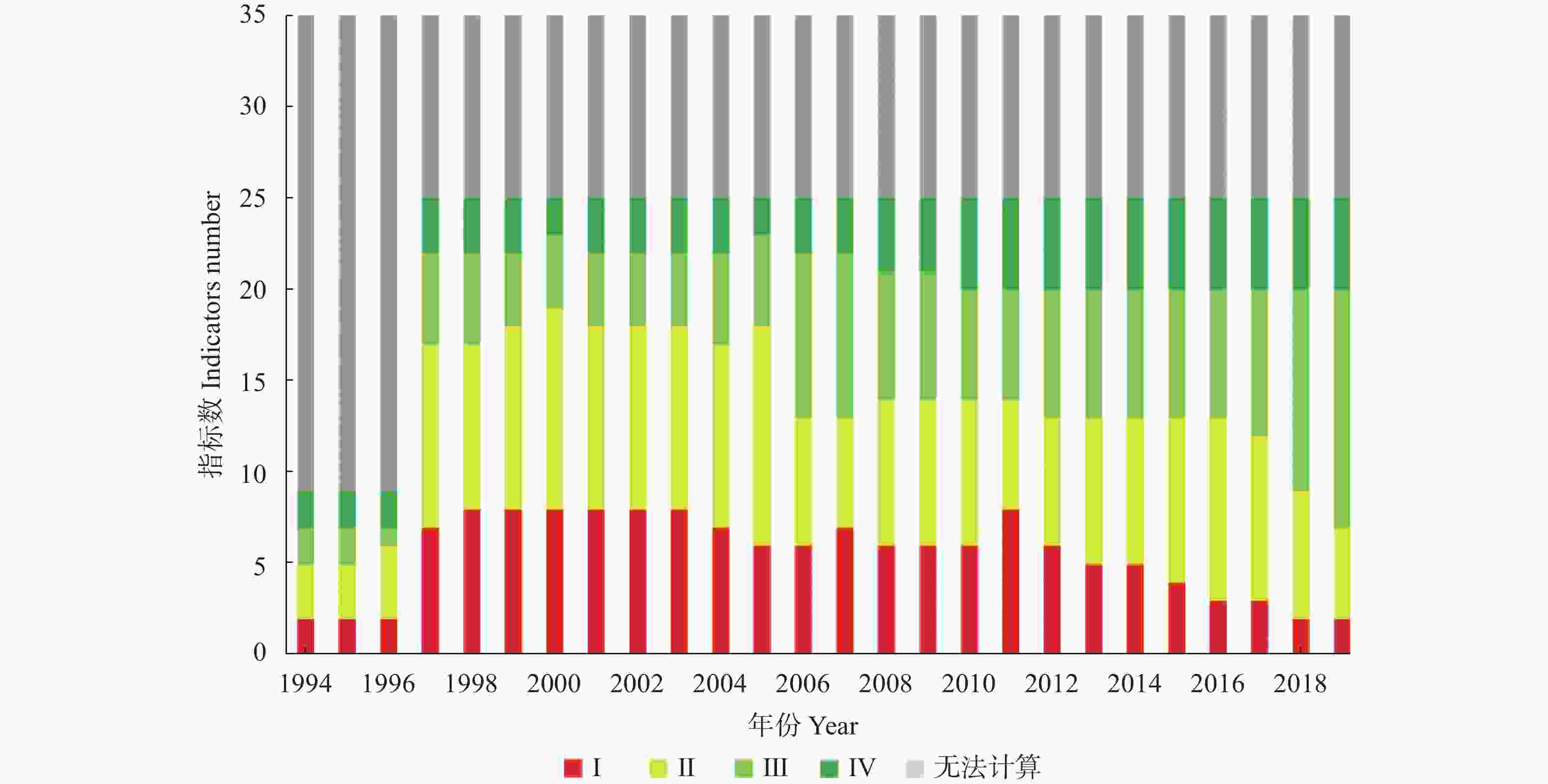
 下载:
下载:
